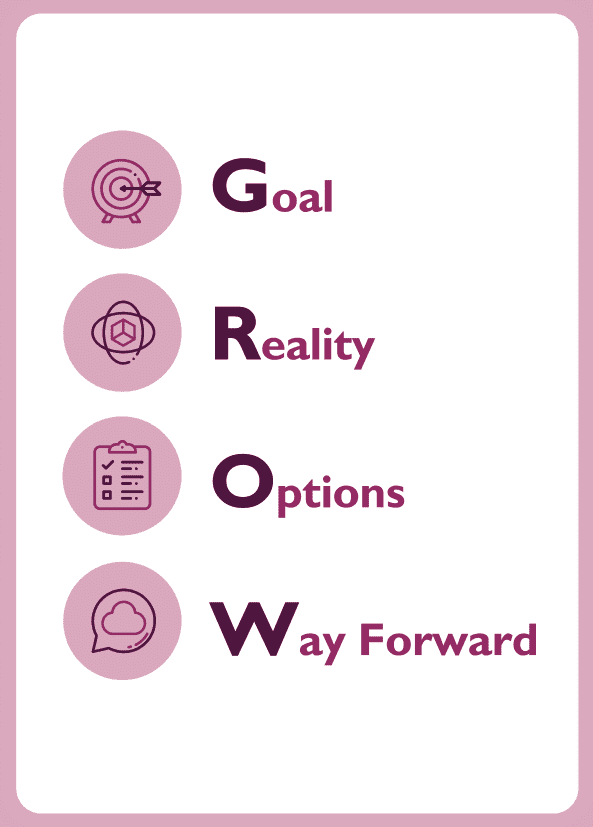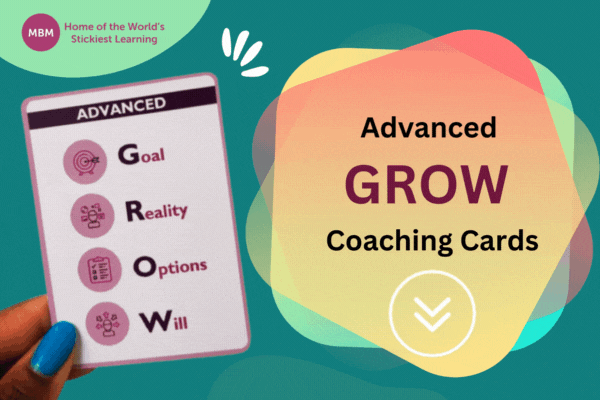Follow These Four Steps, and Transform Your Team
The ‘GROW’ Model is a simple, four-step process coaches can use to lead people towards a goal. Or managers can use it with their teams. And the four steps, or ‘elements,’ are:
- Goal
- Reality
- Options
- Way forward
To start, the ‘GROW’ Model is a Great British invention, that John Whitmore, Alan Fine, and Graham Alexander developed in the late 1980s. And people have used it in corporate coaching and in small businesses ever since. Furthermore, it’s gone on to become a popular model for problem-solving, goal-setting, and improving performance. Have you embraced it in your business yet?
What is the Concept of the ‘GROW’ Model?

The ‘GROW’ Model is a handy coaching framework that cuts through the stodge of traditional mentoring and gives it structure, pace, and relevance. All in all, it helps busy managers come up with the right coaching questions to find out what’s needed now, set goals, and engage with their team members to develop action plans that everybody in the room owns.
Now here’s the thing. ‘GROW’ is different from other coaching approaches, which assume the coach has expert knowledge about people’s individual situations. With ‘GROW,’ the coach acts as a facilitator, helping them work out the best option, not advising or directing. Additionally, everyone is “present,” focused on applying themselves to the task.
The ‘GROW’ Model is brilliantly simple. You can apply all manner of expert thinking and knowledge to the scenario you’re solving. But complexity aside, the process remains the same. You start with an understanding of your reality. Specifically, where do you see yourself on a scale of 1 to whatever, from the worst case to the desired goal? You can’t hope to move on if you’re unclear where you’re starting from. You’ve chosen your goal. Now you need to determine how far away you are, and what you need to do to get there.
What Are the Four Elements of the ‘GROW’ Model?

1- Goal:
Essentially, this is the desired endpoint in your coaching conversation. It’s the reason you’re doing this. Define your goal specifically, so it’s clear when you achieve it. For best results, make goals ‘SMART’ – Specific, Measurable, Achievable, Realistic, and Time-Bound. Have a clear target you want to reach, and an end point.
2- Reality:
So this is where you are now or your current situation. What are the issues and the challenges you’re facing? How far are you from your goal? The Reality stage involves being honest with yourself and your colleagues.
3- Options:
Options are the ways available to you to overcome the ‘GROW’ Model’s other ‘O’s, the obstacles stopping you from reaching your goal. So once you identify these, you must work out how to tackle them and move on.
4- Way:
This covers the steps that will take you to your goal. And these other ‘W’s are part of the planning process:
- What?: What you need to do.
- Why?: Why you need to do it, and what it will achieve.
- Who?: Choosing the people for your team, and your project partners.
- When?: Setting your time schedule.
The ‘GROW’ Model – a Quick Summary
The ‘GROW’ Model underpins coaching tab all levels, whether it’s carried out with groups or individuals. Coaching focuses people on achieving goals, rather than dwelling on past behaviour and ‘failures,’ or having a casual discussion. Thankfully, the ‘GROW’ Model underpins this, providing a framework for each session.
Using the four steps in the ‘GROW’ Model in coaching, and getting the questions right, helps you and your people become the best possible versions of you, and sharpens your skills in important activities like goal setting and problem solving. Additionally, you can use it to catch up on progress, in team meetings, and coaching sessions, or to plan a change.

What Are the ‘GROW’ Model Coaching Questions?
The coach’s skill lies in knowing which questions to use in the situation, and how much detail to go into. For starters, here are some ‘GROW’ coaching questions you can use in these conversations. Bur for best results, draw up your own list before the conversation and ask people for their suggestions.
GOAL:
- What do you want to have, that you don’t have now?
- Where do you want to be, compared to now?
- What are you trying to achieve/tackle?
- Where would you like to be on this problem by the end of the conversation?
REALITY:
- What is the problem? How often does it happen?
- What have you done or tried so far towards achieving your goal?
- What results have you seen from what you’ve done?
- Which things have worked up to now? What hasn’t worked?
- Can you identify who or what is holding you back?
- Who is affected by this, and to what extent?
- What would happen if you didn’t do anything about this?
OPTIONS:
- What would you do if you had more money, time or resources?
- What is possible?
- What are your options?
- What resources do you have that will help? And what other resources do you need?
- Which skills do you have, that will help you reach your goal?
- What other knowledge or skills do you need?
- Is there someone you can bring in to help? What would they do?
- What has worked in the past?
- What are the pros and cons of your options?
WAY FORWARD:
- What are you going to do?
- Which of the options that we discussed will you act on?
- What will it take for you to do that?
- When will you begin?
- What will your first step be?
- How will you measure your progress?
- How will you know when you’ve succeeded?
You can find downloadable PDFs online, with possible ‘GROW’ Model coaching questions.
IMPORTANT: When You Coach With ‘GROW,’ You Put the Other People First
When leaders or managers use ‘GROW’ to coach or mentor their team members, their day-to-day working relationship can get in the way. If you’re naturally an autocratic leader, inclined to chivvy and be critical, and you’re doing the coaching yourself, park your usual instincts. So be kind.
What is the ‘GROW’ Model for Self-development?
So far, we’ve been talking about using the ‘GROW’ Model to coach teams or individuals to meet business goals. But you can also use it in developing people. It works in the same way for addressing previous mistakes and avoiding recurrences; improving performance; modifying behaviour; or planning a career trajectory.
To repeat, it’s better if the person doing the coaching isn’t the boss, as it might be necessary to step outside the previous history of their working relationship for the coaching to be effective.
Here too, you need to start by agreeing on the Goals the person wants to strive for. Ask the Reality questions, to reach a fully rounded sense of the current situation. Select a few appropriate Options questions, and ask them. From there, ask the Way Forward questions. Note, in all stages of the conversation, it’s important to let the person come up with their own answers and solutions, rather than you, the coach, doing it for them.
‘GROW’ Model Coaching

Not surprisingly, the ‘GROW’ model plays a key part in Making Business Matter’s soft skills offering. Our ‘GROW’ and Advanced ‘GROW’ Coaching Cards confirm our expertise as soft skills training providers. We also offer Coaching Skills Training and Executive Coaching courses involving the ‘GROW’ model. But we’ll come back to this later on.
What is the ‘GROW’ Model Template?
There are ready-made ‘GROW’ Model templates available online to print out and use in coaching conversations, with questions on each of the four elements, and space to make notes of the answers.

Are Any Famous Companies Using ‘GROW’?
Yes, they are. Google is among those using the ‘GROW’ model in their coaching conversations. They reportedly use it to help their managers be consistent, free from bias, and productive. But you don’t have to be a big tech company to use ‘GROW.’ In fact, you can apply it in coaching conversations either offline or online, including in Zoom calls.
What Are Some Examples of Uses for the ‘GROW’ Model?
Businesses use the ‘GROW’ Model in various ways. For example, organisations incorporate ‘GROW’ into their management processes and leadership models to engage people, inspire great performance and maximise productivity.
You can apply the ‘GROW’ principles to any goal or challenge:
- Decision making
- Problem solving
- Goal setting
- Addressing technical problems
- Working out processes
- Shaping strategies
- Resolving relationships
- Manage ng work groups and project teams
- Leading sale teams
Getting the Best Out of the ‘GROW’ Model
There is an established ‘GROW’ Coaching feedback model to get the best from a ‘GROW’ coaching session. Ask the team members the following questions:
- What would you like to achieve out of this session or meeting?
- Did you notice anything about your performance?
- What went well or what challenged you?
- May I tell you what I liked as coach?
- If you could do it again, what would you do differently?
- What will it be like when you can do that?
- Can I make a suggestion? Can we discuss…?
- What will you do about this in the future?
What Are the ‘GROW’ Model’s Limitations?
The ‘GROW’ model is task-focused, so it’s good in both work and sports situations. However, this simplicity is one of its strong points. Specifically, it can miss some of the broader context. Remember you need as much detail to hand as possible.
How Long Should ‘GROW’ Coaching Sessions Last?
In executive coaching, it’s common for sessions to last 90 minutes, as they explore people’s aspirations for their careers. Business coaches helping small businesses usually allocate an hour, at monthly intervals. The experts say sales coaching sessions should take place every two weeks and last for 45 minutes. And that’s hard for field-based salespeople. But with more and more salespeople and managers working from home, there’s the opportunity to do it online.
All Hands on Deck – Making Business Matter is Here to Help
Making Business Matter (MBM) offers ‘GROW’ coaching cards as part of its bestselling coaching tools range. MBM’s coaching cards are the most comprehensive selection available, with bigger decks and more choices than anywhere else.
The ‘GROW’ and Advanced ‘GROW’ Coaching Cards confirm Making Business Matter’s expertise as soft skills training providers.
Making Business Matter also provides extensive training in coaching skills. It’s detailed in the article by Kate Burrows on the website, The Ultimate Guide to Coaching Skills.

>> Access Advanced Grow Coaching Cards <<
As Kate writes, coaching helps people reach their full potential by helping unlock their thinking. Even more, this process helps remove mental barriers, including those created by the person being coached.
Thankfully, the ‘GROW’ model helps flag up these barriers. As mentioned, this happens in the ‘O’ stage, when looking at the obstacles stopping you from reaching your goal. From there the talk moves to the Options available to overcome them.
Now many definitions of coaching refer to teaching, telling, or advising. And these imply the coach is an expert of some sort. However, Making Business Matter’s view is clear – this is exactly what coaching is not! Actually, a coach facilitates learning, using their skills to help individuals improve their performance.
Grow Through Training
Making Business Matter’s Coaching Skills Training Course helps managers and leaders focus more energy on the really important stuff. Specifically, the course helps you, as the coach, learn to be fully present in the conversation and ask the right questions. Furthermore, you work on listening with such a high level of engagement that people know you care. As part of the course, you also learn about using the ‘GROW’ coaching model with your teams.
Making Business Matter’s ‘Executive Coaching’ Training Course also includes elements of the GROW Model. The course is delivered by people who have worked in UK grocery. Their backgrounds are either in supermarkets, suppliers, or both. So they understand the challenges grocery people face and can help you overcome them, including by using GROW.
AND FINALLY… How to Make Your Business Really GROW

All in all, using the GROW Model can produce transformational outcomes. But it’s not a magic wand. The coach needs to be self-aware and focused. Here’s why:
- Over-relying on the ‘GROW’ model can make it difficult to move flexibly through coaching sessions. Especially if you keep coming back to one of the stages.
- ‘GROW’ sets out a sequence, but coaching sessions don’t always go in straight lines!
- As a coach, be prepared to be stumped by the answers your coachees come up with.
- Lastly, there’s more to coaching than asking questions. Like therapy, everyone in the session needs to engage with the process.
Overall, to get the most out of using the GROW model, you as the coach and the people being coached need to grasp the underlying principles. The first is awareness – what is this conversation about? How is it going to help us? And the second is responsibility. What have you tried before? Where do you want to go? Take ownership of your part in the conversation.
Remember, the people who are most important in all this are the ones being coached. So keep that in mind, and you’ll really see results.
Updated on: December 13, 2023




